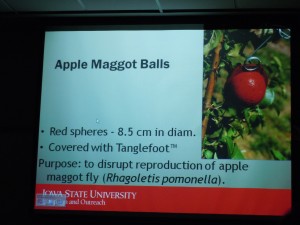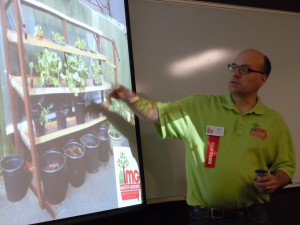
Linn County Master Gardener, Deb Walser, discusses pruning methods for blueberries during the Winter Gardening Fair on Sat. Feb. 16, 2013, at Kirkwood Community College in Cedar Rapids, Iowa. (photo/Cindy Hadish)
How I wish I had taken Linn County Master Gardener Deb Walser’s blueberry workshop 10 years ago. I planted two blueberries back then and the plants languished until last spring, when I finally decided to relocate them. They probably just needed more sun, I decided. That was, of course, the lead-off to Iowa’s drought. As much as I tried to water the relocated plants, they still didn’t thrive. At Deb’s class Saturday at the Winter Gardening Fair, I learned that much more goes into planting blueberries than a typical bush. Iowa’s ground is perfect for so many things, but blueberry plants are not among those. Full sun is appropriate, but just as importantly, the ground must have the proper pH. An acid soil with a pH between 4.5 and 5.5 is ideal, while Linn County’s soil is generally at 6.5. A soil test, followed by acidification with sulfur or peat moss is typically prescribed. Water is another vital necessity for the bushes. I’ll still give blueberries a shot this year, but plan to try them in containers. A large container is needed with a growing mixture of 80 percent bark; 10 percent peat moss and 10 percent compost. The containers need to go into an unheated garage in the winter. Deb said the most difficult part about growing blueberries in the first two years is pinching off the blossoms. Doing so ensures that the plants put their energy into getting established, but you won’t have any berries those first two years.
Linn County Master Gardener, Becki Lynch, predicts Iowa’s drought to continue and offered a full list of trees, shrubs, annuals, perennials and grasses that are considered “drought superheroes.” One point of interest for many Iowans who water their lawns is Iowa State University’s work on drought-tolerant grasses. Fine fescues appear to be the answer, but there is one problem: if you have Kentucky bluegrass, you can’t mix the two. A homeowner would have to remove the bluegrass and replant with fine fescues, Becki said. I prefer her philosophy: “I have a yard, not a lawn,” she said. The yard is diverse, even with less-desired groundcovers such as creeping Charlie, but it looks decent and Becki doesn’t water it. If the drought does continue, watering lawns will be at the bottom of the priority list. No. 1, by the way, will be watering trees.

Apple maggot balls are a less-toxic way of controlling apple maggots than chemical means. (photo/Cindy Hadish)
Patrick O’Malley, ISU Extension Commercial Horticulturist, explored the truth and fiction behind many garden myths. One that I hadn’t heard was the idea that chewed Juicy Fruit gum dropped down a mole tunnel will kill the mole. Patrick debunked that myth. Another pointer I didn’t know about that he mentioned – and this one has more veracity – is the use of “apple maggot balls” to control one of the scourges of apple growers. The balls, which have a sticky surface, apparently are effective, especially when you want something in lieu of chemical control.

Linn County Master Gardener Matt Pieper points to one method of vertical gardening during the Winter Gardening Fair on Feb. 16, 2013, at Kirkwood Community College in Cedar Rapids. (photo/Cindy Hadish)
One of the new aspects to the 2013 Winter Gardening Fair at Kirkwood Community College was two gardening strands: one on vertical gardening and one on the use of water, including rain barrels, ponds and rain gardens. Linn County Master Gardener Matt Pieper did his research to show some awesome vertical gardening methods. Trellises and fences are common, but gardeners are an innovative bunch and have used fabric pockets attached to outside walls; hog panels; old garden gates; wire; bamboo and more for growing structures. One of the most simple was a gardener who planted beans or other climbers in bags of soil with poles inserted to allow the plants to climb. If you have other methods you’ve used, leave a message here or post a photo on Homegrown’s Facebook page.

Always had trouble trying the Blueberry thing as well. Never researched, just hoped that the new chosen location would be better. They grow wild on our east coast up here (Canada) with a smaller but still sweet berry. Maybe a more hardy plant to try here in Ontario if I can get one.
Are you zone 3, Barn? I should have mentioned some of the varieties that are cold-hardy. Those include Patriot and Northland Highbush and Polaris and Northcountry Half-High. Whichever you choose – the highbush, which grows 6-8 feet tall; or the half-highs, which, obviously, grow to half that height – you need at least two for cross-pollination. There are also low-bush varieties that produce smaller blueberries. Make sure you choose two that will bloom at the same time.